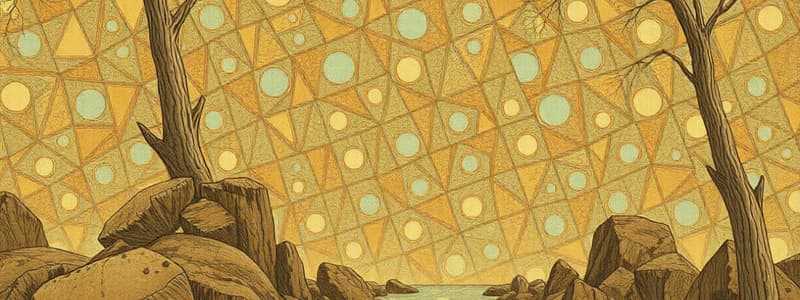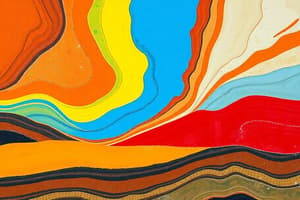Podcast
Questions and Answers
What type of weathering led to the formation of sand and rubble that share the same chemical composition as the rock formation?
What type of weathering led to the formation of sand and rubble that share the same chemical composition as the rock formation?
Which process is primarily responsible for transporting sediments to form layers?
Which process is primarily responsible for transporting sediments to form layers?
If the chemical composition of the rock formation and the rubble are identical, what does this indicate about the weathering process?
If the chemical composition of the rock formation and the rubble are identical, what does this indicate about the weathering process?
What key characteristic differentiates physical weathering from chemical weathering?
What key characteristic differentiates physical weathering from chemical weathering?
Signup and view all the answers
Which of the following processes would likely NOT result in sediment settling in layers?
Which of the following processes would likely NOT result in sediment settling in layers?
Signup and view all the answers
Which term is typically associated with having a definite shape?
Which term is typically associated with having a definite shape?
Signup and view all the answers
What primarily contributes to the formation of sediments on Earth?
What primarily contributes to the formation of sediments on Earth?
Signup and view all the answers
Which of the following is formed primarily by the actions of Earth’s crust?
Which of the following is formed primarily by the actions of Earth’s crust?
Signup and view all the answers
Which of these accurately describes minerals in contrast to rocks?
Which of these accurately describes minerals in contrast to rocks?
Signup and view all the answers
Which factor is least likely to result in the formation of mountains?
Which factor is least likely to result in the formation of mountains?
Signup and view all the answers
What does the letter 'b' represent in the diagram of Earth's layers?
What does the letter 'b' represent in the diagram of Earth's layers?
Signup and view all the answers
Which layer of Earth is located directly beneath the crust?
Which layer of Earth is located directly beneath the crust?
Signup and view all the answers
Which layer of the Earth is the densest?
Which layer of the Earth is the densest?
Signup and view all the answers
What characteristic does the outermost layer of Earth possess?
What characteristic does the outermost layer of Earth possess?
Signup and view all the answers
Which layer of Earth is primarily responsible for seismic wave propagation?
Which layer of Earth is primarily responsible for seismic wave propagation?
Signup and view all the answers
What is formed from the fossilization of plant resin?
What is formed from the fossilization of plant resin?
Signup and view all the answers
If a fossil cast is cut in half, what information can it provide?
If a fossil cast is cut in half, what information can it provide?
Signup and view all the answers
What rock type is the most prevalent in the Grand Canyon?
What rock type is the most prevalent in the Grand Canyon?
Signup and view all the answers
In which type of rock are most fossils typically found?
In which type of rock are most fossils typically found?
Signup and view all the answers
Which fossilization process results in a fossil that is entirely made of rock?
Which fossilization process results in a fossil that is entirely made of rock?
Signup and view all the answers
Which of the following statements is true regarding fossil casts?
Which of the following statements is true regarding fossil casts?
Signup and view all the answers
Which material is NOT typically associated with fossil formation?
Which material is NOT typically associated with fossil formation?
Signup and view all the answers
What is the process called when an organism's liquids and gases are forced out, leaving a film-like residue?
What is the process called when an organism's liquids and gases are forced out, leaving a film-like residue?
Signup and view all the answers
What type of rock is NOT commonly found in the Grand Canyon?
What type of rock is NOT commonly found in the Grand Canyon?
Signup and view all the answers
Which fossilization method preserves the details of an organism in a solid form?
Which fossilization method preserves the details of an organism in a solid form?
Signup and view all the answers
Which group believes that the geological processes occurring in the past are not likely to be repeated?
Which group believes that the geological processes occurring in the past are not likely to be repeated?
Signup and view all the answers
What term describes the belief that current geological processes are similar to those that occurred in the past?
What term describes the belief that current geological processes are similar to those that occurred in the past?
Signup and view all the answers
Which statement reflects the uniformitarian viewpoint in geology?
Which statement reflects the uniformitarian viewpoint in geology?
Signup and view all the answers
Which perspective argues against the likelihood of repeating geological processes from the past?
Which perspective argues against the likelihood of repeating geological processes from the past?
Signup and view all the answers
In the context of the geological processes, what do uniformitarians believe about past events?
In the context of the geological processes, what do uniformitarians believe about past events?
Signup and view all the answers
The vast majority of all fossils on the planet are of which type of organisms?
The vast majority of all fossils on the planet are of which type of organisms?
Signup and view all the answers
Which statement is true regarding the fossil record and currently living organisms?
Which statement is true regarding the fossil record and currently living organisms?
Signup and view all the answers
Fossils found in one layer of stratified rock can be described how in comparison to those in another layer?
Fossils found in one layer of stratified rock can be described how in comparison to those in another layer?
Signup and view all the answers
What percentage of the fossil record consists of hard-shelled organisms?
What percentage of the fossil record consists of hard-shelled organisms?
Signup and view all the answers
What is an implication of the statement that some organisms in the fossil record are still alive today?
What is an implication of the statement that some organisms in the fossil record are still alive today?
Signup and view all the answers
What physical concept is illustrated by the movement of broken pieces of Styrofoam on water's surface?
What physical concept is illustrated by the movement of broken pieces of Styrofoam on water's surface?
Signup and view all the answers
Which term describes the natural forces that wear down the surface of rocks or landforms?
Which term describes the natural forces that wear down the surface of rocks or landforms?
Signup and view all the answers
What is the primary process by which moving water can change the landscape over time?
What is the primary process by which moving water can change the landscape over time?
Signup and view all the answers
Which phenomenon is responsible for the denser materials sinking while lighter ones float on water?
Which phenomenon is responsible for the denser materials sinking while lighter ones float on water?
Signup and view all the answers
What is the study of Earth's physical structure, its history, the processes acting on it, and the rocks of which it is composed?
What is the study of Earth's physical structure, its history, the processes acting on it, and the rocks of which it is composed?
Signup and view all the answers
What term describes a surface of erosion that separates one layer of rock from another?
What term describes a surface of erosion that separates one layer of rock from another?
Signup and view all the answers
What is the main difference between erosion and deposition?
What is the main difference between erosion and deposition?
Signup and view all the answers
What happens to temperature and pressure the deeper you go into the Earth?
What happens to temperature and pressure the deeper you go into the Earth?
Signup and view all the answers
Which of the following fields of study focuses on the atmosphere and weather phenomena?
Which of the following fields of study focuses on the atmosphere and weather phenomena?
Signup and view all the answers
What is the term for the natural feature formed by the layering of sedimentary rocks?
What is the term for the natural feature formed by the layering of sedimentary rocks?
Signup and view all the answers
What layer of the Earth is represented by the letter 'c' in the diagram?
What layer of the Earth is represented by the letter 'c' in the diagram?
Signup and view all the answers
What term describes the decayed remains of once-living creatures?
What term describes the decayed remains of once-living creatures?
Signup and view all the answers
Which layer of the Earth is primarily responsible for tectonic activity?
Which layer of the Earth is primarily responsible for tectonic activity?
Signup and view all the answers
Which option is not a characteristic of the crust?
Which option is not a characteristic of the crust?
Signup and view all the answers
What is a common method used to date fossils?
What is a common method used to date fossils?
Signup and view all the answers




